
 |
The ValuPoint can be a Modbus RTU master or slave. As a master you can read Modbus data from, or write Modbus data to, other Modbus slaves. The ValuPoint will periodically poll the other Modbus devices according to register maps you set up. To read from a remote Modbus device, configure a Read Map. To write to a remote Modbus device, configure a Write Map.
Data read from a remote device is stored in a local register when received. Data written to a remote device is taken from a local register when sent. The local registers are the same collection of registers that are accessible to the SNMP MIB.
The following section details the process of setting up read and write maps via the web interface. Once familiar with map content, you have the option of importing bulk configurations as a CSV file. The import function is found on the File Manager page, and details about the content and format of the CSV file are found in Appendix B.
Modbus device configuration for RTU really consists of just port configuration. When brand new out of the box, the RTU port defaults to RTU slave.
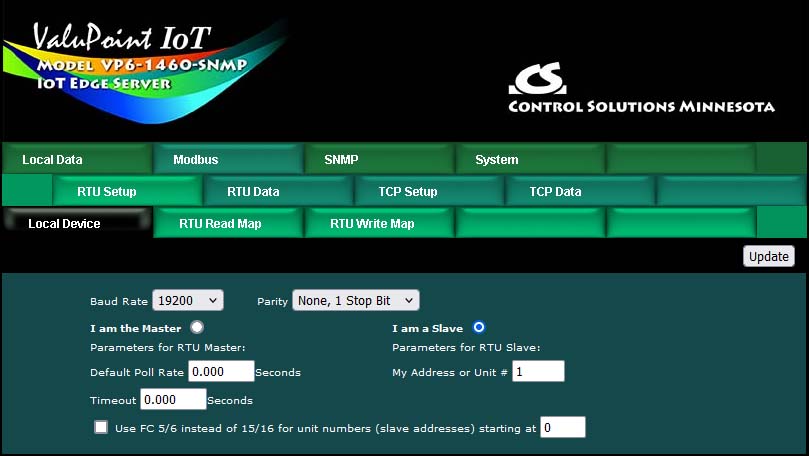
Select baud rate and parity from the drop down list. Click either Master or Slave buttons to select type of operation. Enter timing parameters or address as applicable. Click update to register your changes.
The default poll rate entered here will be used for all Modbus RTU Read and Write maps unless a different number is entered in the expanded view of the map.
IMPORTANT: Set timeout to something long enough for the device. If too short, the ValuPoint will not wait long enough for a response from the Modbus slave device, and the result will be a lot of "no response" errors from the device even though the device is perfectly functional.
If your slave/server device only supports function codes 5 and 6 for writing coils and holding registers, check the Use FC 5/6 box. The default function codes are 15 and 16, which are most widely used. If you check the box, you should also enter a "starting at" unit # or slave address. This allows supporting both types of devices at the same time provided you assign slave addresses in two non-overlapping groups. (These settings do not apply if the ValuPoint is the slave.)
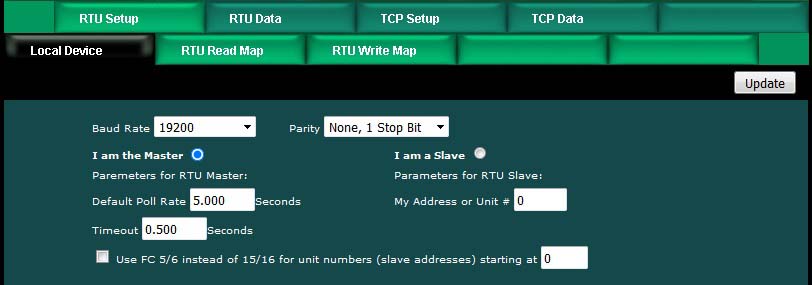
Getting the ValuPoint to read registers from another Modbus device requires setting up a "Read Map" as shown here.
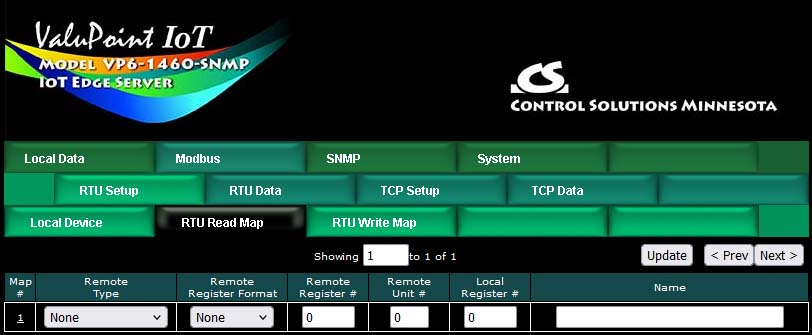
Map number simply tells you where you're at on the list of register maps. Click "next" and "prev" to scroll through the list. To advance directly to a specific map, enter the desired number in the "Showing" box, then click Update.
Maps entered on this page only read data from remote devices. Go to the RTU Write Map to write data to those devices. The full parameter set is different for read versus write.

To create a Read Map, start by selecting the Modbus register type to read from the drop-down list.
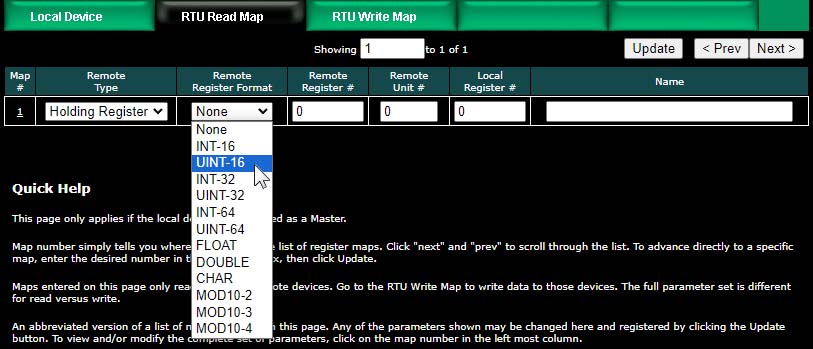
Select the data format expected in the remote Modbus register. The abbreviation INT under Format means signed integer, while UINT represents unsigned integer. The INT and UINT are followed by the number of bits to be read (which translates into 1, 2, or 4 consecutive holding registers). The FLOAT format refers to 32-bit IEEE 754 format while DOUBLE refers to 64-bit IEEE 754 floating point. The MOD10 format is unique to Schneider Electric power meters, and is supported in 2, 3, and 4-register formats. (Note: Use INT-16 or UINT-16 for coils or discrete inputs - in this case format only affects local register data conversion.)

Enter the register number to read from the remote RTU slave and slave address of that RTU slave. Do not use Modicon numbers here. In other words, if your slave device's documentation says read register 40001, that is short hand (Modicon notation) for saying read holding register 1. Refer to the Modbus Reference Information section of this user guide for more discussion about register numbers like 40001. If you enter 40001 here to read the first holding register, you will get an exception error since the actual register number is not 40001.
The Local Register is where data read from the remote Modbus RTU slave will be stored locally in the ValuPoint. If the local register data format does not match what you are reading from the Modbus slave, the data will be converted automatically when it is read.

Click on the Map number in the first column to access the expanded view of the Read Map.
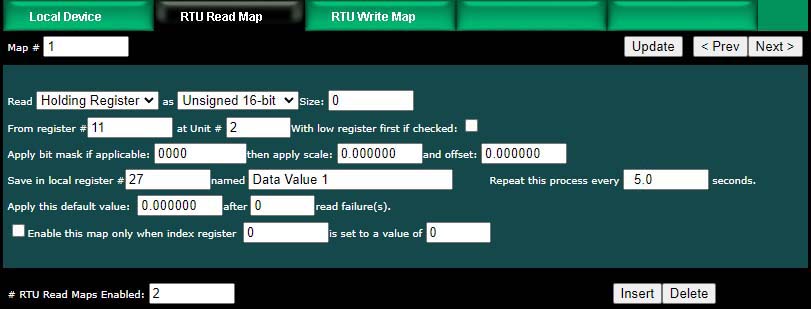
For each remote register to be read, select the register type, format, number, and remote unit (slave address). The optional bit mask and scaling are discussed with examples below.
Modbus protocol treats all input registers or holding registers as strictly 16-bit registers. To accommodate 32-bit or longer data, Modbus devices use multiple consecutive "registers" to hold the data. There is no standardization of whether the least significant part of the data comes first or last. Therefore, ValuPoint lets you set that according to whatever the slave device requires. If the least significant data is found in the first (or lower numbered) register in your slave device, then check the box after "With low register first".
The poll rate ("Repeat this process...") determines how often the remote register will be read. If zero is entered here, the rate will become the default poll rate given on the Devices page for the Modbus RTU port.
The default value will be stored into the local register after the given number of read failures if the fail count is non-zero. Setting the count to zero will disable the default, and the object will retain the most recent value obtained. If the default value does take effect, the actual data value read will be retained when communications are restored.
You have the option of making this Read Map conditional. If an index register number is provided and the Enable box is checked, then this read map will only be executed when the index register (local register) contains the value given. This allows multiple read maps to supply data to the same local register based on the value of the index register. It also allows reading to simply be suspended if a single read map supplies data to the local register. In a more sophisticated scenario, you could potentially suspend reading of the slave if you know the slave is powered down.
Map number simply tells you where you're at on the list of register maps. Click "next" and "prev" to scroll through the list. To advance directly to a specific map, enter the desired number in the "Map #" box, then click Update.
Delete will remove the map number shown in the "Map #" box. Insert will insert a new map before the map number shown, and is used for placing maps between existing maps. It is not necessary to use Insert to add maps to the bottom of the list or to define any map presently having zero for a source object or "none" for remote type.
Selecting "none" for remote type effectively deletes the map even though it will still appear in the list until deleted. Unused maps at the end of the list will always show none as the type. If you wish to prevent these from being displayed, reduce the number of maps enabled.
The number of maps enabled simply limits the scope of map review so that you do not have to review a lot of unused maps. If the displayed maps are used up and you need more, increase the enabled number.
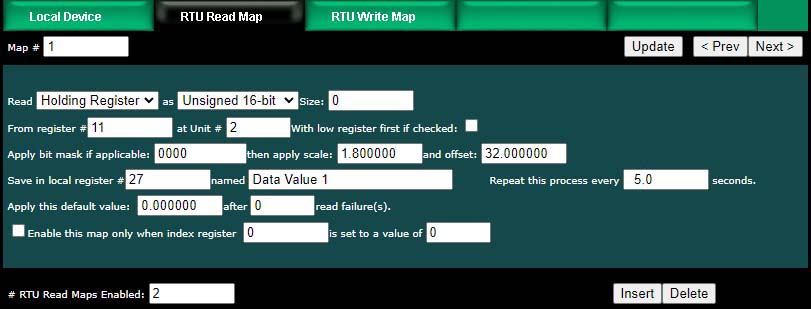
You have the option of providing a scale and offset. A scale of zero will cause scale and offset to be ignored. If provided, the Modbus data will be treated as raw data. When the Modbus data is received, it will be multiplied by scale, then added to offset, and then stored in the local register. If the Modbus slave was providing degrees Celsius, and the scale factors illustrated above were used, then a Modbus value of 25 would result in the local register receiving a value of 77 (degrees Fahrenheit).

It is common for Modbus devices to pack a number of status bits into a single holding register. In order to do meaningful things based on a single bit, it is sometimes necessary to split that register into multiple local registers. ValuPoint supports this requirement by providing an optional bit mask.
If a bit mask is entered (in hexadecimal), and the remote register type is signed or unsigned integer (16-bit or 32-bit data), the mask will be bit-wise logical AND-ed with the Modbus data, and the retained bits will be right justified in the result stored locally.
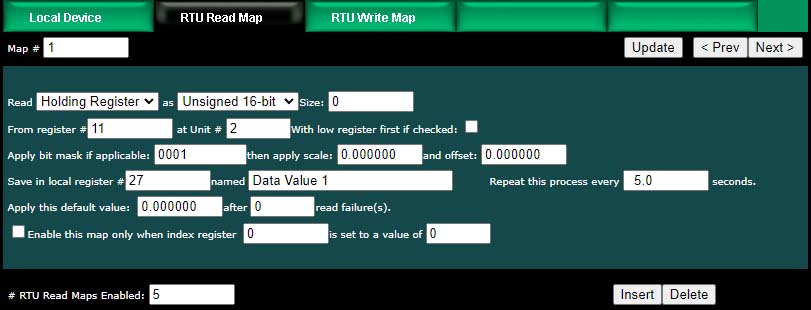
Reading bit 0 is illustrated above while reading bit 3 is illustrated below (bit 3 mask in binary would be 1000 which is hexadecimal 8 as entered in the configuration page). Refer to the Modbus Reference section in this user guide for a list of all possible mask values.
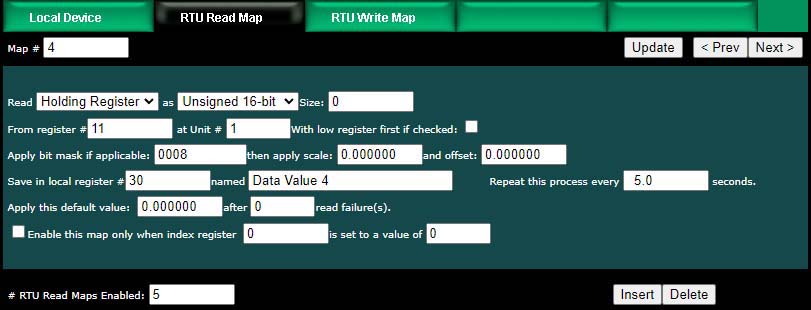
If the read maps referencing the same remote register are created in sequential contiguous order, the ValuPoint will optimize the RTU activity by reading the remote register once and then sharing the data with all of the read maps in the group. In the example illustrated here, four consecutive read maps reference the same remote register, each selecting a different bit. The first map is selecting bit 0, the second selecting bit 1, and so on.

To try out these read maps, we have set up ModSim with the remote register 11 containing a value of 7.
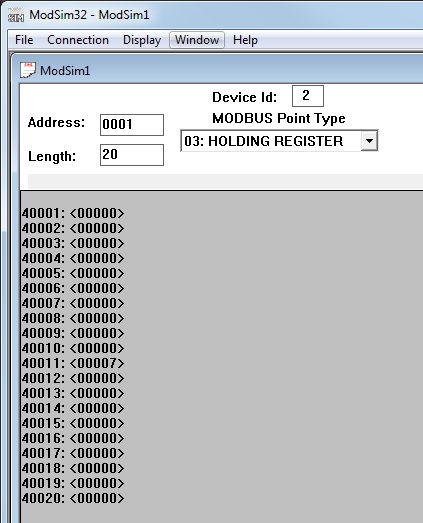
The holding register value of 7 translates into the following local register values when the bit mask option is used as illustrated.

Getting the ValuPoint to write registers to another Modbus device requires setting up a "Write Map" as shown here. Much of the Write Map is configured the same as a Read Map.

The data direction is reversed but the same selections are still made. Select the local register that will be the source of data to write to the remote Modbus RTU slave. Select the register type, data format, and register number to be written to in that slave. Enter the slave address as Remote Unit. Click on the map number in the first column to access additional optional configuration parameters.
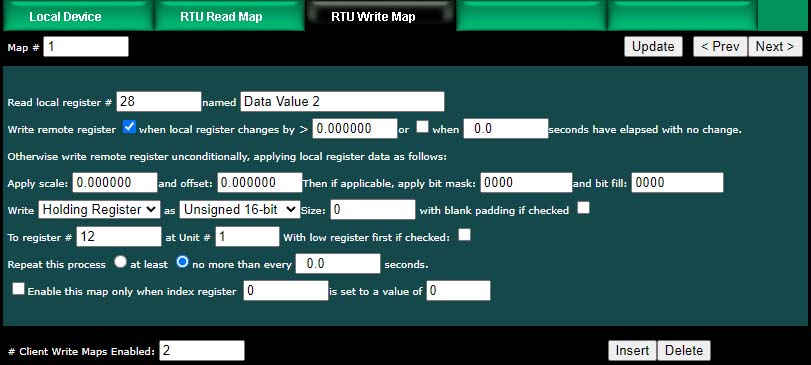
The local register data may be written to the remote slave periodically, or when it changes, or both. To send upon change (send on delta), check the first box and enter the amount by which the local register must change before being written to the remote device. To guarantee that the remote register will be written at least occasionally even if the data does not change, check the second box and enter some amount of time. This time period will be referred to as the "maximum quiet time".
Data from the local register may be manipulated before being written to the remote register. The local data is first multiplied by the scale factor. The offset is then added to it. If a bit mask is entered, and the remote register type is signed or unsigned integer (16-bit or 32-bit data), the mask will be bit-wise logical AND-ed with the data. The mask is right justified, then AND-ed with the data. The result is then left shifted back to the original position of the mask. In other words, the least significant bits of the original data will be stuffed at the position marked by the mask.
After the scaling and masking, the bit fill will be logically OR-ed into the result, but only if the mask was nonzero and was used. Both mask and fill are entered in hexadecimal. The effect of "fill" is that certain bits will always be set to 1 in the data written to the remote Modbus device.
Multiple local registers may be packed into a single remote register. To accomplish this, define two or more maps in sequence with the same remote destination. If the destination is the same, data types are 16 or 32-bit integer (signed or unsigned), bit masks are nonzero, and the maps are sequential, the results of all qualifying maps will be OR-ed together before being sent to the remote destination.
For the remote register to be written, select the register type, format, number, and remote unit (slave address). Data formats are the same as described above for Read Maps. Size is only specified for character strings. Use INT-16 or UINT-16 data format for coils - in this case format only affects local register data conversion.
Modbus protocol treats all holding registers as strictly 16-bit registers. To accommodate 32-bit or longer data, Modbus devices use multiple consecutive "registers" to hold the data. There is no standardization of whether the least significant part of the data comes first or last. Therefore, ValuPoint lets you set that according to whatever the slave device requires. If the least significant data is found in the first (or lower numbered) register in your slave device, then check the box after "With low register first".
The repeat time may determine how often the remote register will be written. If send on delta and maximum quiet time are not checked above, clicking the "at least" button will establish a periodic update time. If send on delta is used and you wish to limit the network traffic when changes are too frequent, click the "no more than" button and enter the minimum time that should elapse before allowing another write to the remote device. It is valid to select "no more than every 0.0 seconds" if you want all changes to be sent, but no periodic writes.
You have the option of making this Write Map conditional. If an index register number is provided and the Enable box is checked, then this write map will only be executed when the index register (local register) contains the value given. This allows multiple write maps to supply data to the same remote register based on the value of the local index register. It also allows writing to simply be suspended if a single write map supplies data to the remote register. In a more sophisticated scenario, you could potentially suspend writing of the slave if you know the slave is powered down.
Delete will remove the map number shown in the "Map #" box. Insert will insert a new map before the map number shown, and is used for placing maps between existing maps. It is not necessary to use Insert to add maps to the bottom of the list or to define any map presently having zero for a source register or "none" for remote type.
Selecting "none" for remote type effectively deletes the map even though it will still appear in the list until deleted. Unused maps at the end of the list will always show none as the type. If you wish to prevent these from being displayed, reduce the number of maps enabled.
The RTU Registers page shows a list of local registers mapped to RTU slave devices. The page will show only one device at a time, and may have no entries as illustrated below.

Click the Next Unit button to go to the next RTU slave, or simply enter a number in the RTU Unit # window and click Update. Registers for that slave will now be displayed. In addition to a summary of the map (both read and write maps are shown), the time since last update is displayed. This time should generally be less than the poll time. If the last update time is large, it means there is an error preventing the update.

The Error Counts page shows a tabulation, by RTU slave, of all errors observed. In the example below, we can see that the RTU device at slave address 1 is running flawlessly while slave #2 has had some issues.
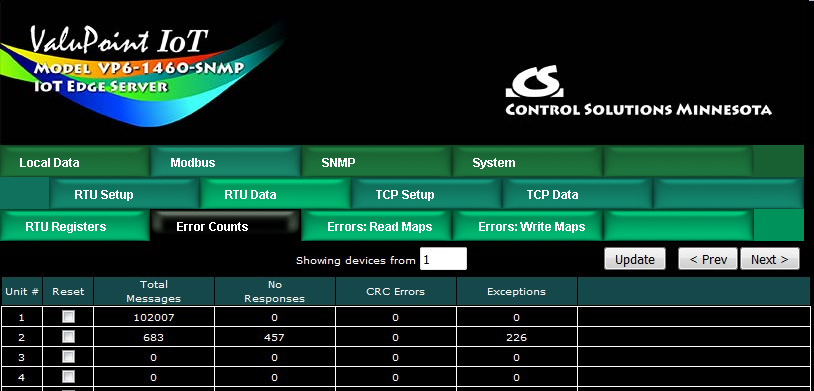
If the counts show some problems, we can look for more detail on the Errors: Read Maps (or Errors: Write Maps) pages. These pages will tell us exactly which Read Map (or Write Map) the problem is occurring on, and what the error is, as illustrated below.

When the problem is resolved, it will be removed from this list.

Once you have resolved problems, you can reset the error counts by checking the box in the Reset column and then clicking Update.

The counts will reset to zero, but in most cases, at least "Total Messages" will start incrementing again.
